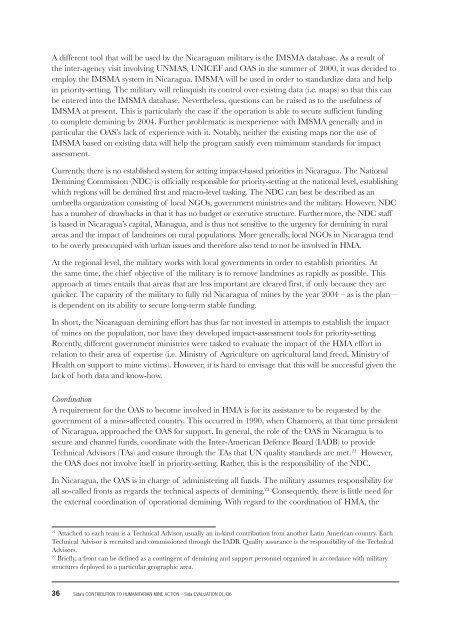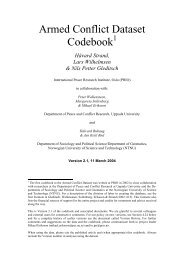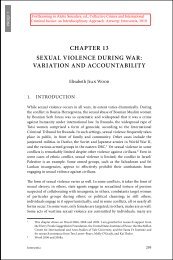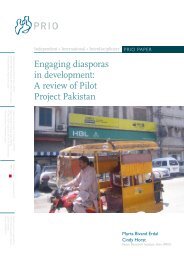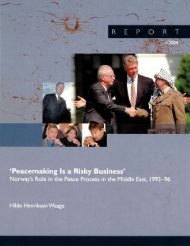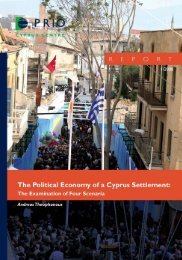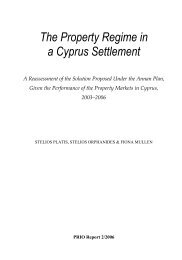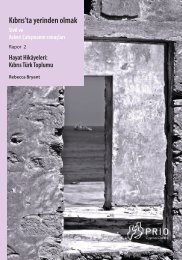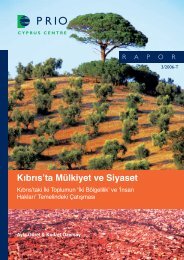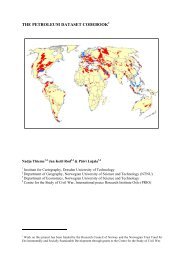Sida's Contributions to Humanitarian Mine Action
Sida's Contributions to Humanitarian Mine Action
Sida's Contributions to Humanitarian Mine Action
Create successful ePaper yourself
Turn your PDF publications into a flip-book with our unique Google optimized e-Paper software.
A different <strong>to</strong>ol that will be used by the Nicaraguan military is the IMSMA database. As a result ofthe inter-agency visit involving UNMAS, UNICEF and OAS in the summer of 2000, it was decided <strong>to</strong>employ the IMSMA system in Nicaragua. IMSMA will be used in order <strong>to</strong> standardize data and helpin priority-setting. The military will relinquish its control over existing data (i.e. maps) so that this canbe entered in<strong>to</strong> the IMSMA database. Nevertheless, questions can be raised as <strong>to</strong> the usefulness ofIMSMA at present. This is particularly the case if the operation is able <strong>to</strong> secure sufficient funding<strong>to</strong> complete demining by 2004. Further problematic is inexperience with IMSMA generally and inparticular the OAS’s lack of experience with it. Notably, neither the existing maps nor the use ofIMSMA based on existing data will help the program satisfy even mimimum standards for impactassessment.Currently, there is no established system for setting impact-based priorities in Nicaragua. The NationalDemining Commission (NDC) is officially responsible for priority-setting at the national level, establishingwhich regions will be demined first and macro-level tasking. The NDC can best be described as anumbrella organization consisting of local NGOs, government ministries and the military. However, NDChas a number of drawbacks in that it has no budget or executive structure. Furthermore, the NDC staffis based in Nicaragua’s capital, Managua, and is thus not sensitive <strong>to</strong> the urgency for demining in ruralareas and the impact of landmines on rural populations. More generally, local NGOs in Nicaragua tend<strong>to</strong> be overly preoccupied with urban issues and therefore also tend <strong>to</strong> not be involved in HMA.At the regional level, the military works with local governments in order <strong>to</strong> establish priorities. Atthe same time, the chief objective of the military is <strong>to</strong> remove landmines as rapidly as possible. Thisapproach at times entails that areas that are less important are cleared first, if only because they arequicker. The capacity of the military <strong>to</strong> fully rid Nicaragua of mines by the year 2004 – as is the plan –is dependent on its ability <strong>to</strong> secure long-term stable funding.In short, the Nicaraguan demining effort has thus far not invested in attempts <strong>to</strong> establish the impac<strong>to</strong>f mines on the population, nor have they developed impact-assessment <strong>to</strong>ols for priority-setting.Recently, different government ministries were tasked <strong>to</strong> evaluate the impact of the HMA effort inrelation <strong>to</strong> their area of expertise (i.e. Ministry of Agriculture on agricultural land freed, Ministry ofHealth on support <strong>to</strong> mine victims). However, it is hard <strong>to</strong> envisage that this will be successful given thelack of both data and know-how.CoordinationA requirement for the OAS <strong>to</strong> become involved in HMA is for its assistance <strong>to</strong> be requested by thegovernment of a mine-affected country. This occurred in 1990, when Chamorro, at that time presiden<strong>to</strong>f Nicaragua, approached the OAS for support. In general, the role of the OAS in Nicaragua is <strong>to</strong>secure and channel funds, coordinate with the Inter-American Defence Board (IADB) <strong>to</strong> provideTechnical Advisors (TAs) and ensure through the TAs that UN quality standards are met. 21 However,the OAS does not involve itself in priority-setting. Rather, this is the responsibility of the NDC.In Nicaragua, the OAS is in charge of administering all funds. The military assumes responsibility forall so-called fronts as regards the technical aspects of demining. 22 Consequently, there is little need forthe external coordination of operational demining. With regard <strong>to</strong> the coordination of HMA, the21Attached <strong>to</strong> each team is a Technical Advisor, usually an in-kind contribution from another Latin American country. EachTechnical Advisor is recruited and commissioned through the IADB. Quality assurance is the responsibility of the TechnicalAdvisors.22Briefly, a front can be defined as a contingent of demining and support personnel organized in accordance with militarystructures deployed <strong>to</strong> a particular geographic area.36 Sida’s CONTRIBUTION TO HUMANITARIAN MINE ACTION – Sida EVALUATION 01/06


